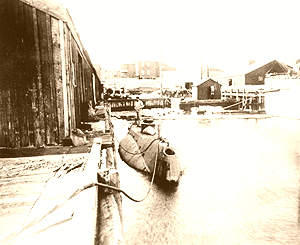
The Naval Torpedo Station saw much growth in the 1900s through present day:
The Holland submarine (right), designed and built by J.P. Holland, was purchased by the Navy in early 1900 for $120,000. For armament, she carried a nitroglycerin gun and one torpedo tube with five Whitehead torpedoes.
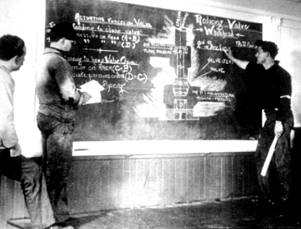
Training continued at the Naval Torpedo Station during the early 1900s (left). Both officers and enlisted men were instructed in a wide range of technical subjects, including torpedoes, diving, mines, gun-control systems, torpedo boat and submarine operations, and countermining.
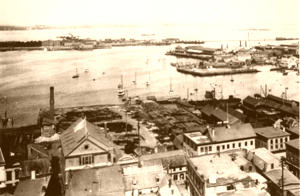
The Naval Torpedo Station at Goat Island in 1910 (right). The activity had greatly expanded to support its involvement in torpedo production.
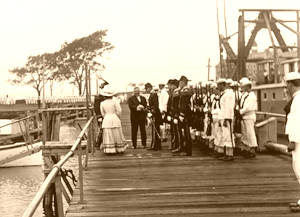
Theodore Roosevelt comes ashore at the Naval Training Station in 1913 (left).
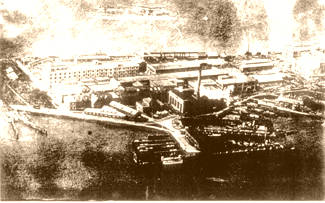
The Naval Torpedo Station as it appeared in 1920 (right). The torpedo station grew dramatically during World War I and provided the resident expertise and facilities required to respond to the Navy’s urgent wartime operational needs.
During the war, thousands of Naval personnel were trained in the use of weapons, more than 1,000 torpedoes were manufactured, and hundreds of primers, fuses, bombs and explosive devices were produced.
The Naval Torpedo Station also responded to urgent demands to develop depth bombs and mines that played a significant role in bringing the U-boat campaign under control.
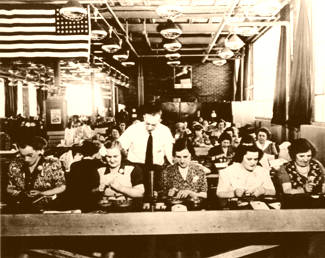
The need for primers significantly increased during World War I and their fabrication was a delicate, labor-intensive effort.
During the war, production was more than 200,000 primers per year, and more than 3,200 people were employed to produce them. Of the 3,200 people, 300 were women, and they demonstrated superior skills and dexterity in the delicate handwork needed to produce primers.
With women in the factory (left), primer output increased from 5,000 per week to 8,000 per day. Women averaged more than six times the output of men, explaining why the Naval Torpedo Station was an early equal opportunity employer.
World War II era
By World War II, the Goat Island facility complex became and industrial activity primarily dedicated to the production of ordnance. Naval Torpedo Station personnel worked around the clock to manufacture torpedoes during the war.
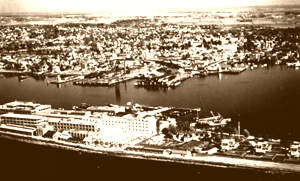
The Naval Torpedo Station became a pretty impressive site during the 1940s (right). The Naval Torpedo Station produced more than 18,000 torpedoes during World War II, almost twice as many as any other single torpedo manufacturing activity. Also, during that time, the torpedo station was exclusively involved in correcting fleet or production problems. As the most experienced activity, the Naval Torpedo Station frequently had to retool and switch production in response to changing fleet requirements or to cover shortfalls because of production problems at other activities. In addition to this impressive production record, the torpedo station was also extensively involved in proofing torpedoes and preparing them for fleet issue.
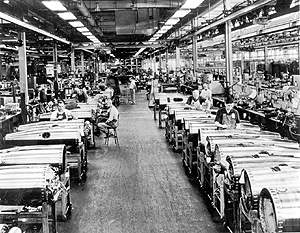
Naval Torpedo Station personnel (left) hard at work testing and proofing torpedoes. During World War II, the new Gould Island firing range proved its worth, as over 75,000 torpedoes were proof-fired by the Naval Torpedo Station in support of the Navy’s torpedo programs.
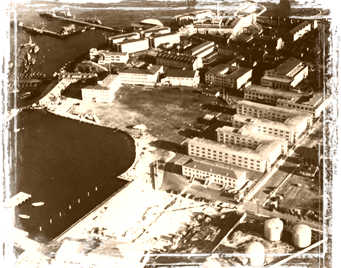
From 1945-70, the Navy Underwater Sound Laboratory in New London, Conn., (right), was the center of sonar development for both surface ships and submarines, and a predecessor organization of the Naval Undersea Warfare Center Division Newport.
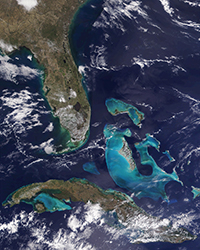
In ceremonies directed by Vice President Hubert Humphrey, the decade-long effort to establish a deep water test and evaluation range with 3-D capabilities culminates with the official commissioning of the Atlantic Undersea Test and Evaluation Center (AUTEC) on Andros Island in The Bahamas in 1967. AUTEC is adjacent to the embayment known as Tongue of the Ocean (right) and has shore-based support headquarters in West Palm Beach, Fla.
Learn more about AUTEC by clicking here.
Two NAVSEA Warfare Centers – the Naval Surface Warfare Center and the Naval Undersea
Warfare Center – officially were stood up in 1992, as part of an overall Department of the Navy consolidation of research, development, test and evaluation (RDT&E), engineering and fleet support activities. Rear Adm. William C. Carlson serves as commander and Earle Messere as technical director of the new Naval Undersea Warfare Center, which is located with the Division in Newport.
In 2003, the Naval Surface Warfare Center and the Naval Undersea Warfare Center begin operating as an integrated entity in order to collaborate with customers, adopt a common work assignment process, increase efficiency and shift from a site-centric model to a national business model. A NAVSEA Warfare
Centers Board of Directors, made up of the two flag commanders and the executive director of NSWC and NUWC, is established. Learn more about this Command by clicking here.
Click here to read NUWC's history from 1869 to 1900.